Climate of the Sierra Nevada
Sierra Nevada Climate Drivers
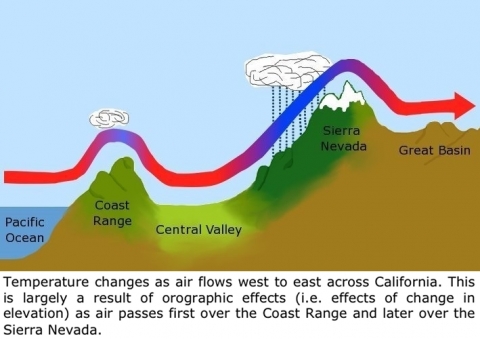 |
As rain clouds travel eastward from the Pacific Ocean, those that cross over California meet a formidable labyrinth of towering walls and winding valleys known as the Sierra Nevada. The physical form and geographic orientation of this mountain range are integral to the climate patterns of both the Sierra Nevada and the regions that surround it. Prevailing winds push clouds against the western slopes of the Sierra Nevada. Forced upward, the air cools adiabatically at an average rate of about 6.5ºC per 1,000 meters (3.3ºF per 1,000 feet). As it cools, water vapor in the air condenses, forming the rain, hail, sleet, or snow that falls upon the western slopes of the Sierra Nevada. By the time the wind rushes the clouds over the mountain crests, the clouds have relinquished much of their precipitation. The air continues down the eastern slopes, warming adiabatically as it descends. By now there is little moisture remaining in the air. As a result, the region east of the Sierra Nevada crest receives very little precipitation. This phenomenon—the rain shadow effect—is largely responsible for the arid climate of the eastern Sierra Nevada and the Great Basin.
Climate cycles such as the Pacific Decadal Oscillation (PDO) and the El Niño-Southern Oscillation (ENSO) periodically cause deviations from the usual climate conditions. PDO phases occur every 20-30 years, while ENSO phases occur every 2-7 years. Depending on the phase and intensity of the cycle, the Sierra Nevada may experience precipitation patterns that are significantly higher or lower than usual. For example, by February 2016 the robust El Niño of 2015-2016 generated considerable amounts of rain and snow in California and the Sierra Nevada, punctuating a severe four-year drought. Though this brought a much-needed reprieve to California, the long-term outcome is still uncertain. Precipitation and snowpack levels will need to stay well above normal for an extended period of time if they are to balance out the effects of California's prolonged water deficit.
Current Climate in the Sierra Nevada
Visitors from humid regions will find that the air often feels noticeably dry in the Sierra Nevada, especially during the summer. Humidity is even lower at high elevations because the air is at a lower atmospheric pressure, which reduces its capacity to hold water vapor and other gases. At high elevations the air is thin, making aerobic exertion more difficult and permitting more ultra-violet radiation to reach the ground. This increased UV exposure makes UV protection important on sunny days, even when the air feels cool. The lack of moisture also reduces the heat capacity of the air and causes rapid temperature changes that produce strong winds.
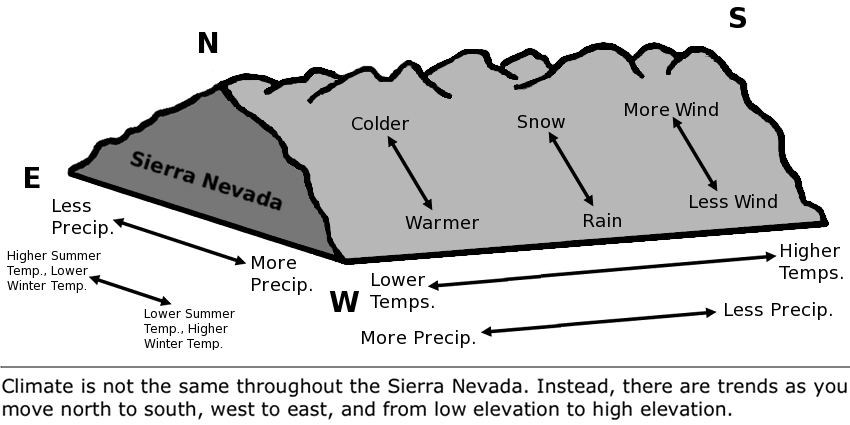 |
Weather can be difficult to predict in the Sierra Nevada due to the heterogeneous topographies and microclimates of this region. Winters are generally cold and wet, while summers are typically warm and dry. Scattered summer thunderstorms are common, but they account for less than 3% of the total annual precipitation. More than half of the annual precipitation falls from January through March. Precipitation drops abruptly below about 1,000 meters (3,000 feet), and there is a steady decrease in precipitation as one moves from north to south along the Sierra Nevada. Most of the snow in California typically falls in the Sierra Nevada. Accordingly, the Sierra Nevada snowpack furnishes much of California's water supply as winter gives way to warmer seasons and snow begins to melt.
Climate Change in the Sierra Nevada
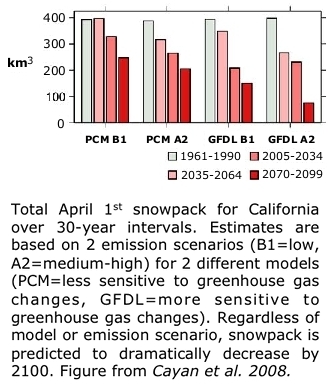 |
Climate models predict that the Sierra Nevada will experience warmer winters, earlier spring warm-up, and warmer summers. By 2100, temperatures in the Sierra Nevada are predicted to increase by about 1.7°C to 5.8°C (3.1°F to 10.4°F), with the amount of increase depending on future emission scenarios and local topography. Warmer, drier summers will likely be accompanied by larger and more intense fires in certain areas, including the Sierra foothills. In addition, the area of land burned annually is expected to increase, especially in the eastern Sierra Nevada. Although this will be problematic in the short term, these conditions may eventually lead to vegetation changes that inhibit severe wildfire regimes over the long term.
The effects of climate change on total precipitation are uncertain and hard to predict because of the diverse topography and complex weather patterns of the Sierra Nevada. More precipitation is expected during the winter, with more of it falling as rain instead of snow. This will shrink the end-of-winter snowpack, with the greatest snow loss expected in the central and northern Sierra Nevada. In this scenario, winter streamflow will increase. Because winter temperatures are also expected to rise, snow will melt sooner and peak spring streamflow will arrive earlier. However, spring precipitation is expected to decrease, and coupled with a dwindling snowpack that melts early, this will diminish late spring and summer streamflow in snow-fed rivers and streams. Thus, the hot, dry summers of today will likely be even more pronounced than they are at present.
Effects of Climate Change on Sierran Flora and Fauna
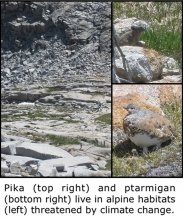 |
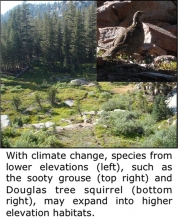 |
Some species shift their ranges in response to changes in precipitation. In the Sierra Nevada, this can mean moving downslope if precipitation and water availability increase at lower elevations. Other species shift their ranges in response to rising temperatures. Cold-adapted plants and animals can either advance into colder latitudes, or escape to higher elevations. In the Sierra Nevada, such species can and do shift their ranges upslope; however, mountains are finite. These climate change refugees face an ever-shrinking area of suitable habitat as higher elevations gradually warm over time. Species such as the white-tailed ptarmigan and the pika are among the many species that may one day run out of ideal habitat.
While high elevation life zones are expected to contract, the story is different at lower elevations. Here, life zones like grasslands and foothills are expected to expand. Plants and animals associated with these habitats are in less danger, and may actually benefit. For instance, birds of foothill, montane chaparral, and sagebrush habitats seem less threatened by climate change than those in subalpine and alpine environments. Species in these habitats may even experience population increases or range expansions. In another example, even while the ranges of small mammals from high-elevations are expected to contract, the ranges of small mammals associated with low elevations are expected to expand into higher elevations. As time progresses, these range shifts will likely alter the community compositions of many Sierra Nevada ecosystems.
Riparian communities across the Sierra Nevada face difficult challenges as well. In a future where rain progressively supplants snow, peak flows will arrive earlier in the season, and winter streamflow will rise significantly. A smaller snowpack will release less water to streams during spring and summer, reducing streamflow during the warmest and driest part of the year. Thus, species that depend on snow-fed aquatic systems or on the timing of peak streamflow for key life cycle processes may become even more vulnerable than they are now.
More Information
Average precipitation and temperatures in Tuolumne Meadows and Yosemite Valley: http://www.nps.gov/yose/planyourvisit/weather.htm.
Current Yosemite Valley weather: http://forecast.weather.gov/MapClick.php?lon=-119.60798&lat=37.73271.
Current road, lodging, campground, and trail conditions in Yosemite: http://www.nps.gov/yose/planyourvisit/conditions.htm.
Weather data for Dana Meadows, Gin Flat, Ostrander Lake, Tenaya Lake, Tioga Pass, Tuolumne Meadows, Wawona, White Wolf, and Yosemite Valley: http://www.nps.gov/yose/learn/nature/hydrology-data.htm.
Works Cited
Adiabatic Temperature Change: http://regentsearth.com/ILLUSTRATE%20GLOSSARY/Adiabatic.htm
The Orographic Effect:http://regentsearth.com/ILLUSTRATED%20GLOSSARY/Orographic.htm
Schoenherr, Allan A. 1992. A Natural History of California. University of California Press: Berkeley, CA.
Storer, Tracy I. et al. 2004. Sierra Nevada Natural History. University of California Press: Berkeley, CA.
National Weather Service: Current Yosemite Valley Weather: http://forecast.weather.gov/MapClick.php?lon=-119.60798&lat=37.73271
National Park Service: Current Conditions: http://www.nps.gov/yose/planyourvisit/conditions.htm
National Park Service: Weather data from stations in Yosemite National Park and snow data: http://www.nps.gov/yose/learn/nature/hydrology-data.htm
National Park Service: Yosemite Temperatures and Precipitation: http://www.nps.gov/yose/planyourvisit/climate.htm
US Climate Data: http://www.usclimatedata.com/climate/yosemite-natl-park/california/united-states/usca1269
US Climate Data and Free Climograph: http://www.usclimatedata.com/climate-on-your-site.php?id=usca1269
Millar, Constance I. 2012. Geologic, climatic, and vegetation history of California. In: Baldwin, Bruce G.; Goldman, Douglas H.; Keil, David J.; Patterson, Robert; Rosatti, Thomas J.; Wilken, Dieter H., editors. The Jepson Manual: Vascular Plants of California. 2nd Edition. University of California Press. pp. 49-67. http://www.fs.fed.us/psw/publications/millar/psw_2012_millar003.pdf?
California Department of Fish and Wildlife: Climate and Topology: https://www.dfg.ca.gov/biogeodata/atlas/pdf/Clim_12b_web.pdf
Los Angeles Times: California officials upbeat about snowpack, but long-range prospects are unknown. http://www.latimes.com/local/lanow/la-me-ln-snowpack-20151230-story.html
National Oceanic and Atmospheric Administration: What is the El Niño-Southern Oscillation (ENSO) in a nutshell? https://www.climate.gov/news-features/blogs/enso/what-el-ni%C3%B1o%E2%80%93southern-oscillation-enso-nutshell
National Centers for Environmental Information: Pacific Decadal Oscillation (PDO) https://www.ncdc.noaa.gov/teleconnections/pdo/
Siegel, R. B., P. Pyle, J. H. Thorne, A. J. Holguin, C. A. Howell, S. Stock, and M. W. Tingley. 2014. Vulnerability of birds to climate change in California's Sierra Nevada. Avian Conservation and Ecology 9(1): 7. http://dx.doi.org/10.5751/ACE-00658-090107
Maurer, E. P. 2007. Uncertainty in hydrologic impacts of climate change in the Sierra Nevada, California, under two emissions scenarios. Climatic Change 82:309-325. https://www.researchgate.net/profile/Edwin_Maurer/publication/225400575_Uncertainty_in_hydrologic_impacts_of_climate_change_in_the_Sierra_Nevada_California_under_two_emissions_scenarios/links/0912f507c2694abebf000000.pdf
Cayan, D. R., E. P. Maurer, M. D. Dettinger, M. Tyree, and K. Hayhoe. 2008. Climate change scenarios for the California region. Climatic Change 87(Suppl 1):S21-S42. http://meteora.ucsd.edu/cap/pdffiles/Cayan_calif_scen_jan2008.pdf
Herring, S. C., M. P. Hoerling, T. C. Peterson, and P. A. Stott, Eds., 2014: Explaining Extreme Events of 2013 from a Climate Perspective. Bull. Amer. Meteor. Soc., 95 (9), S1–S96.
http://www2.ametsoc.org/ams/assets/file/publications/bams_eee_2013_full_...
Crimmins, S. M., S. Z. Dobrowski, J. A. Greenberg, J. T. Abatzoglou, and A. R. Mynsberge. 2011. Changes in climatic water balance drive downhill shifts in plant speciesʹ optimum elevations. Science 331:324-327.http://dx.doi.org/10.1126/science.1199040
Lenihan, J. M., D. Bachelet, R. P. Neilson, and R. Drapek. 2008. Response of vegetation distribution, ecosystem productivity, and fire to climate change scenarios for California. Climatic Change 87:S215-S230.http://dx.doi.org/10.1007/s10584-007-9362-0
Moritz, C., J. L. Patton, C. J. Conroy, J. L. Parra, G. C. White. and S. R. Beissinger. 2008. Impact of a century of climate change on small-mammal communities in Yosemite National Park, USA. Science 322(5899):261-264. https://www.researchgate.net/publication/23310064_Impact_of_a_Century_of_Climate_Change_on_Small-Mammal_Communities_in_Yosemite_National_Park_USA
PRBO Conservation Science. 2011. Projected effects of climate change in California: ecoregional summaries emphasizing consequences for wildlife. Version 1.0. PRBO Conservation Science, Petaluma, California, USA. [online] URL: http://data.prbo.org/apps/bssc/climatechange
Thorne, J. H., B. J. Morgan, and J. A. Kennedy. 2008. Vegetation change over sixty years in the central Sierra Nevada, California, USA. Madroño 55:223-237. http://dx.doi.org/10.3120/0024-9637-55.3.223
van Mantgem, P. J., and N. L. Stephenson. 2007. Apparent climatically induced increase of tree mortality rates in a temperate forest. Ecology Letters 10:909-916. http://dx.doi.org/10.1111/j.1461-0248.2007.01080.x



